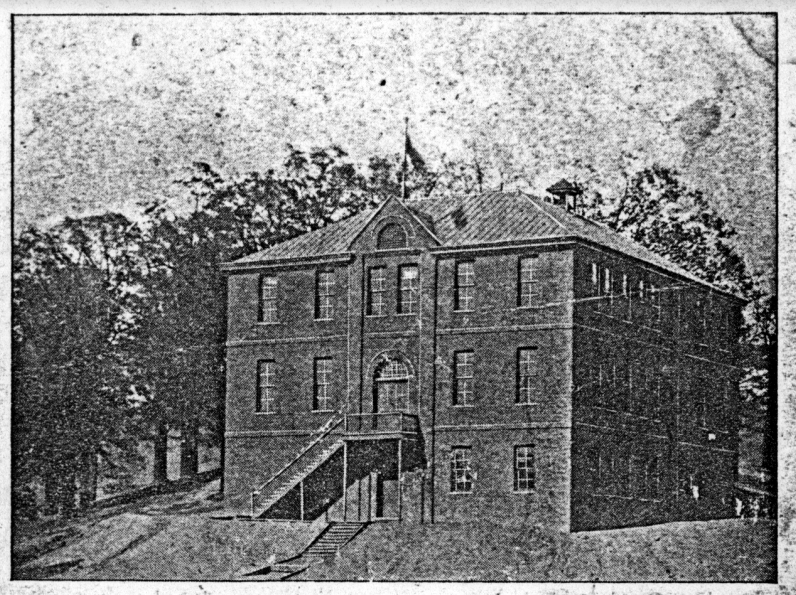Last week we began our look at a 1917 article from the Saturday Morning edition of The Asheville Citizen, titled “Death Toll At Catholic Hill School May Be Eight Children.” Catholic Hill School, built in 1892, was Asheville’s first school building constructed to serve the African-American community. Seven students would perish in the fire. The building would also be destroyed in the flames.
Thanks as always to the Pack Memorial Library’s Special Collections, North Carolina Room for its assistance. Additional thanks to UNC Asheville’s Special Collections for providing us with this week’s photograph. For last week’s post, click here.
On Saturday, Nov. 17, 1917 the The Asheville Citizen reported:
As the word spread, and seemed confirmed, that some children had been destroyed in the holocaust, there were pitiful scenes among the anxious relatives of the missing children. Hours passed: the fire department dynamited the walls in three places, to make the burned building a safe place for searchers; and then, while the streams were still playing on the blazing timbers, out of the steam and the smoke came a group of blackened firemen bearing the first small charred body. Fearfully the mothers and fathers strained to see the little one, and then they moved back in horrified dismay, as they realized that the thing they looked on bore hardly any resemblance to a human being. Last night in the undertaking establishment, the line of seekers passed slowly by the row of charred bodies, and sought in grief-stricken silence to identify by some trinket or bit of undestroyed clothing the loved one whom they feared to find. Others telephoned to relatives and questioned small companions to learn just how their own children had been dressed. And by this process three of the children’s bodies, those of Henry and Elsie Thompson and Mary Jamison had been identified at a late hour last night.
Darkness ended the heroic labors of the firemen, who were searching among the ruins for the bodies of those still missing, while keeping streams of water on the hot ashes and charred timbers. They will take up the search this morning, clear the site, and conclude their gruesome task within a few hours it is expected. Much commendation is merited by the firemen for their prompt response, when once the alarm was turned in, and for their heroic fight after reaching the scene. At the time of their arrival, the flames were roaring from the third story windows. A few minutes fight, with a strong north wind fanning the flames and making it almost impossible to attack the blaze through the windows, showed that the building was doomed, and the men turned some attention to saving adjoining buildings, including the annex to the school. In fighting the fire three firemen were hurt. B.F. Matthews was cut about the head and L.W. Jeanneret had his hand badly cut by glass falling from the second story, while Jennings Fitzgerald received a sprained ankle in dodging a falling wall.
“Considerable money had been expended by the city,” stated Commissioner [D. Hiden] Ramsey last night, “in order to make this building as safe as possible against fire. There is only one safe building, and that is the absolutely fire-proof building. In the case of this fire, it has been stated that it started with an explosion in the boiler room. In its present state, the room is intact, disproving this theory absolutely. It is probable either that the blaze started with an over-heated theory, or through carelessness in the boys’ toilet, which adjoins the furnace room. A cigarette surreptitiously smoked and dropped there might have made trouble.” The janitor of the building, Mr. Ramsey stated, had put in several shovelsful of coal on the fire, and had gone up town for his regular, weekly trip to the superintendent’s office for the school’s supplies. In the absence the fire may have started by the furnace becoming too hot: but this is only another theory, and the faithful service of the janitor is such that no carelessness can be imputed to him without some stronger proof.
In an interview last night with Fire Chief J.H. Wood and Assistant Chief A.L. Duckett, they stated that there was no delay after the receipt of the alarm, and every effort was made to save the building, which was at the time of their arrival afire all over. Professor Lee had put on a fire drill in the school, and had emptied the building in sixty seconds, only a few minutes before the fire. This was a good record under normal conditions, and it has been witnessed by the commissioner of public safety and others a number of times. Yet while the loss of eight lives is deplorable, in view of the information received from the teachers as to the extent to which the fire had gone before they discovered it, it is remarkable that in the fire and smoke only eight were lost, when it might easily have been a hundred, had it not been for the splendid discipline existing in the school.
Fire broke out in the ruins about 11 o’clock last night and W.M. Alexander, Thomas Morris, Eugene Ford, I. H. Smith, George Hatton, Robert Love and Burrell Wright, all colored, were summoned by an officer, who was in the vicinity, and fought the flames for more than an hour, finally conquering them



I missed first part of this series. Where was this building located in Asheville?